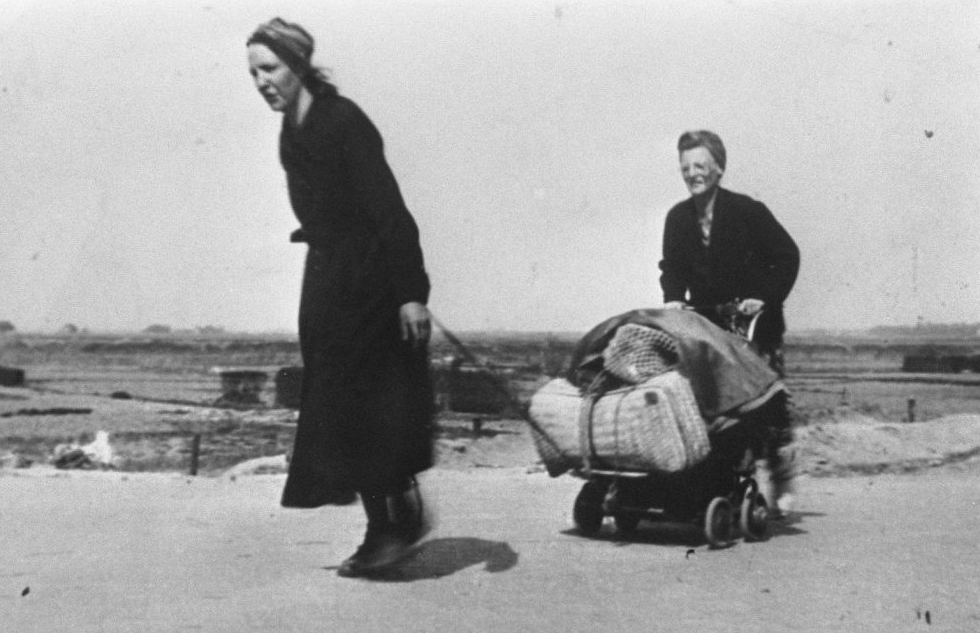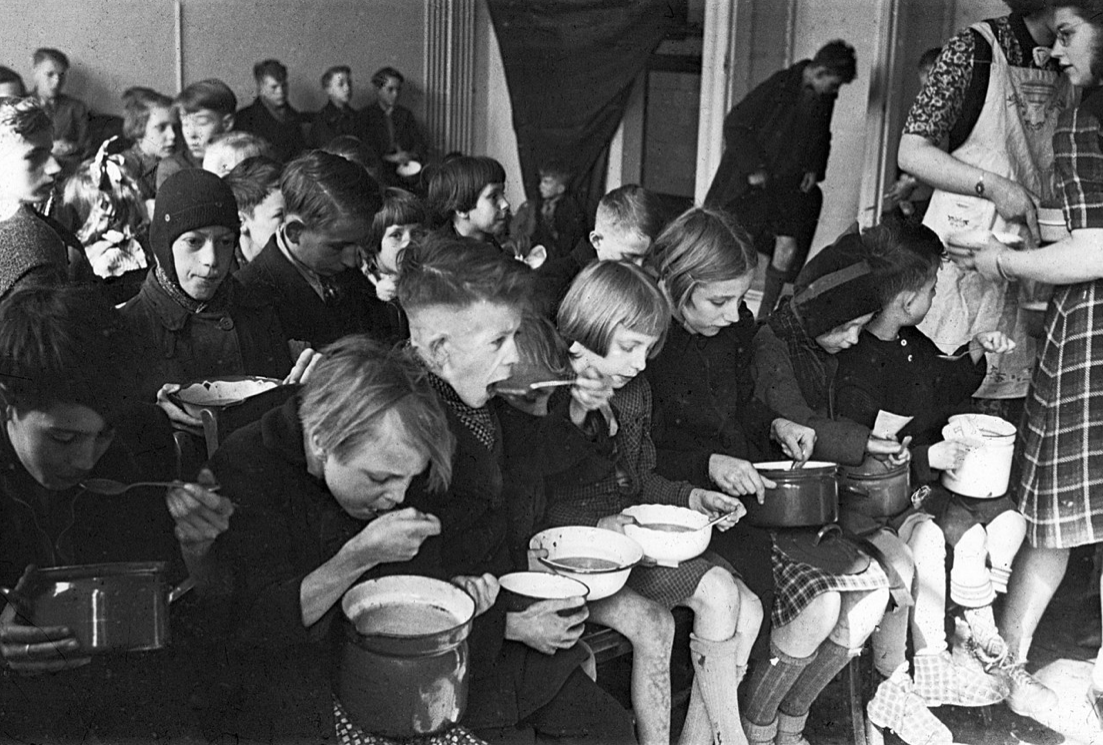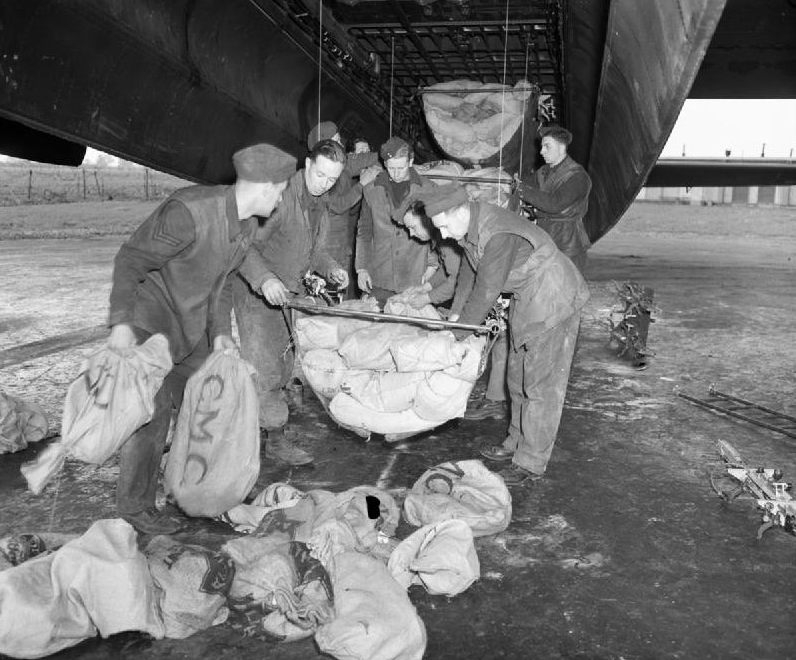The Hunger Winter took place as World War II was in its final year. Following a German blockade, food supplies to the Netherlands dwindled, and people began to starve.
It was a rare instance of famine in a developed and wealthy country in recent history. Let’s talk about it.
Why was there a Hunger Winter?
If the Dutch had survived the war so far without running into food shortages, why was there a famine in the winter of 1944? There were a couple of reasons.
The obvious and literal cause of the famine was a German blockade enacted in retaliation to a Dutch railway strike that aimed to help the Allied invasion of the country.
The German army blocked water and road routes into the Netherlands and only lifted the water blockade when temperatures had already fallen too low to allow boats to operate in the icy conditions.

At this point in the war, Allied forces had liberated the south of the Netherlands. But as the forces pushed further north, the failure of Operation Market Garden impeded their progress.
READ MORE | The Hague in World War II: Paratroopers, V2 rockets and the British bombing the Bezuidenhout
The Allied forces failed to seize a bridge over the Rhine at Arnhem. They decided to focus on other parts of the liberation process first, including capturing the French ports of Calais, Boulogne and Dunkirk.
Their progress into Germany slowed down at the time because they couldn’t use the port of Antwerp.
How did people survive the Hunger Winter?
Between 18,000 and 22,000 people died during the Hunger Winter, most of whom were older men. When we talk about survival rates, it’s important to remember that it was not just the supply of food hampered by the blockade.
It was also the supply of heating fuel: coal.
So, not only was it a very hungry winter, but it was also a very cold winter for the Netherlands from 1944 to 1945.
READ MORE | The Dutch ship that disguised itself as an island during World War II
The starvation was particularly intense in cities — after all, in the countryside, most people lived around farms. That didn’t mean they didn’t experience food shortages, but the survival rates were much higher outside urban areas. For the Netherlands’ city-living population, times were hard.

So how much food did people consume during the Hunger Winter?
Rations decreased in calorie content over the long winter. In big cities like Amsterdam, adults had to contend with only 1000 calories of food by the end of November 1944 — but that dropped to 580 calories a day by February 1945. Even the black market was empty of food.
People walked long distances to farms to trade anything they had for extra calories. As the winter wore on, tens of thousands of children were sent from cities to the countryside so that they, at least, would get some food.
When it came to heating, people desperately burned furniture and dismantled whole houses to get fuel for their fires.
How did the Hunger Winter end?
The Hunger Winter came to a close in May 1945 when the Allies liberated the Netherlands. However, Allied efforts partially alleviated the starvation of the Dutch population.

Sweden shipped flour, and the Dutch made it into bread to feed the people. The Germans also allowed airdrops of food supplies from the end of April forward.
What were the effects of the Hunger Winter on the Netherlands in the long term?
The Hunger Winter had long-term effects on the health of the Dutch population. Even when the blockade ended and people returned to eating normally, starvation had long-lasting effects on the body.
The Dutch Famine Birth Cohort Study revealed that the children of women who had starved during the Hunger Winter had health problems: including higher rates of diabetes, obesity, and cardiovascular disease. One study also showed that the grandchildren of women who had experienced famine were smaller than average at birth.
How is the Hunger Winter remembered in the Netherlands today?
The Hunger Winter is usually remembered in conjunction with the resistance movement during World War II. There is an exhibition on it at the Resistance Museum in Amsterdam, for example. There are also statues commemorating the Hunger Winter.
READ MORE | The 14-year-old assassin who lured Nazis and traitors to their deaths
The Hunger Winter wasn’t the first time people in the Netherlands had experienced starvation — the Siege of Leiden during the Eighty Years’ War was another occasion where food shortages affected the population.
Did we miss anything important about the Hunger Winter? Let us know in the comments below.
Editor’s Note: This article was originally published in December 2019 and was fully updated in November 2023 for your reading pleasure.

My mother a widow in Halfweg drove on a bicycle with solid tyres kilometers with me a four year old along farms in the poulder to find food only to reach a farm where food was given out that day as she was told to meet a closed gate.I was lucky at to eat sugar beet while mum had to eat tulip bulbs.I learned from mum never to throw away any food.I still taste the swedish white bread and chocolate .
Great story Kees. I was born in Zwanenburg and heard many horrible stories from my father.
It has also been noted that children that were conceived and born around this time have greater difficulty with anxiety and stress that has had an effect on their entire lives.
Those were extreme difficult conditions for the dutch citizens – during the end of WWII – sugar beets seemed to be the only survival food. Many died of starvation – conditions were cruel and citizens paid a dear price as a result of the German invasion of their country.
My mother was one of six siblings and they all suffered ill health throughout their lives. All but one died in their sixties. I have always said that deprivation in the war was the cause of their ill health and early death.
My Oma was one of the hunger children mentioned in this article . Poor skinny thing was sent to a farm for a period where there was more food and milk . 25 years later she returned to the farm 250 pounds and almost 6 foot tall.
Apparently during that period, they also ate tulip bulbs
If they were lucky enough to get hold of any. I was only 6, but what I saw, straight after liberation, I will never forget. From South Limburg, we were liberated on 13 September 1944. My parents were in the avant Gaurd of the Dutch Resistance and I only had 2 brothers, 6 and 8 years older than me, regardless of age, we were all active members, one way or the other. I spoke an understandable English, learned from Churchill while listening to him on the clandestine radio under the roof, where there were always people hidden, I was born in 1937. I am writing my memoirs and having a big problem writing past 1943/1945. There are many pictures in my head that come alive when I look at them and the more I look, the more extensive the scene gets.Never left me, in particular in my old age, the more I write down, the more scenes come back to me. My initial intention was to just briefly mention it, more than ten years ago. The active group of this Resistance formed the first Dutch Batallion , trained in “The Harskamp”. All survivors of this batallion were at my wedding in 1958, same house, same street, right next to the most Southern big Railway Station, Wyck/Maastrocht
Ik ga nog over m”n nek als ik eraan denk
My mother, who was a teenager at that time, told me about the ”hongertochten” she made with her father. I learned from here to empty my dishes …
If I’m not mistaken, this gave way to extreme innovation in farming and agriculture, as the Dutch wanted to prevent being dependent on imports for survival for the generations to come. Today the Netherlands is second largest exporter of agricultural products in the world.
yes, my mother’s family suffered hunger and cold during this hunger winter in the Netherlands. My aunt ‘s digestion was never the same; she couldn’t really eat anything and died in her early 60s. My Mother suffered from malnutrition in her teeth, nails and bones all thru her life. When she came to the US in 1946, it took a long time for her to be able to eat anything but bits of food. But since living in the US, she lived a long time into her life, 88. Her middle sister was on a farm during the war so she had food but not alot of it. They ate the beets and tulip bulbs. we learn from their experiences.
I was born at the end of October 1944 in Amsterdam, the city hardest hit by the “hongerwinter.” My father was “ondergedoken” in our apartment from the Germans. My Mom, pregnant with me, would go out on her bike, either by herself or with her brother, and barter for food with the farmers. On one occasion my Father paid 100 guilders for a loaf of bread. Times were desperate but our family survived.
I’ve been researching for information about Catholic orphanages that were located in or near the Hauge in 1944. The stories I’ve read are heartbreaking. Thank you all for sharing.
I missed the part of children who wereld sent to the Northern provincies from the cities in the west. They were sent to farms to survive. My father was sent from the Hague to Friesland.
During that time, we ate soup from the ”gaar keuken,as I was told . soup was made from tulip bulbs,
my dad and brother and sister went to Overijsel bij handcar,to pick up some potatoes,etc. we lived in Amersfoort,they walked for 60 km one way,on the way back the germans schot on many people who went that way to survive,and landed up side down in the ditch.some did not survive.wood was taken from near by plantsoen, to keep de kachel going.there is so much narigheden te vertellen.Many gave their lives for our freedom.good to read all the replies.
My grandmother – my grandparents lived in the Rivierenbuurt in Amsterdam during the war – told me how during the Hunger Winter with dollars they had at home, they bought food on the black market and everyday, she fed 20 boys from the streets with one warm meal a day. “Mijn jongens” she called them. During that same winter, my grandfather decided to get my great-grandmother from her home in Koog a/d Zaan, 30 km north of Amsterdam, because the old widow of 87 was starving. Since there were no trains, my grandfather of 54 got a sled which he pushed over the frozen canals in the horrible cold all the way to Koog a/d Zaan, put his mother onto that sled together with a mountain of blankets and her personal belongings, and pushed the sled all the way back to Amsterdam. My granddad’s health was never the same afterwards.
But there are other stories, like that of a math teacher of mine, a German, who told me he was a soldier of the Amsterdam garrison during that winter. The soldiers were ordered by their officers NOT to give the starving people any food. But he an his comrades every morning put bread and sausage in their great-coats, and while they were walking guard, they secretly gave the food to the starving Dutch children.
Three stories about the Hunger Winter I got first-hand and that I now have shared.
Actress Audrey Hepburn was famous for her tiny waist. But she said she got it because her digestion was destroyed by starvation as a youth in the Netherlands during the war. She had difficulty with her digestion her entire life.
i remember and lived in tHE hAGUE AND THE TIME
at the time AND SURVIVED , DO NOT KNOW HOW, WAS SEND TO A FARM NEAR THE BELGIUM BORDER TO REGAIN MY HEALTH, I LEARNED HOW TO PRAY DURING THE LAUNCHING OF THE V2, MANY OF THEM WOULD FAIL THE LAUNCH AND CRASHED IN THE NEIGHBORHOODS KILLING MANY PEOPLE, BUT AT 88 I AM STILL HERE,MAYBY THE SUGAR BEES AND TULIP BULBS ARE GOOD FOR
, tom
YOUR HEALTH
I researched and wrote a book about the Hunger Winter. Hunger Winter: A WW2 Novel tells the true story of the final winter of the war in the form of historical fiction. Over sixty readers have given it a 5 star review and the Corrie ten Boom Foundation, whose museum commemorates WW2, said, “I would love to encourage everyone to read this book.” Hunger Winter: A WW2 Novel is available on Amazon and other sites where books are sold.
Is it in English?
How cold did it get that winter?
somehwere between 0 C and -18 C
Thank you fir this information. My late husband Henk Mulder often spoke about that time. His father Gerard, had been taken away by the Germans in about 1943 for forced/slave labour, I presume in Germany. Henk did not see his dad until after the war ended. Gerard got caught up with the Russian Army, on his way back home to Zeist. He never wanted to speak about it. They migrated to Australia in 1956 on the ship Johan Von Barneveldt. I have never been able to find out where in Germany he was sent, or how he journeyed back home.
The Dutch national archives opened sites where you can find out about your father
My mother was in Amsterdam. 16 years old when the war finished. Told me her mum made soup by boiling pieces of wood to give it flavour. She said there wasnt a rat, cat or dog left as they all got eaten. She was about 6 foot 2 and weighed less than 60 kg I think. Didn’t menstruate until she gained weight after the war. Was sent to Austria after the war to fatten her up. It didnt work. Her health was pretty bad overall (diabetes, heart disease, strokes and cancer 3 times) and she died at 69. I was the youngest of 6 kids and she also suffered 6 miscarriages. I think my old e siblings know more, but this is mostly what she told me.
I was born in 1940 and went through the hunger winter we were eating sugar beets and tulip bulbs to survive my older brother’s were away days on end to get food for their siblings
I have a copy of a 1955 Spiegel magazine in which there are photos of the hunger winter. Men removed railway sleepers for firewood.. A picture of a young man dead from hunger on the sidewalk.. columns of people walking from South Holland to get food in Friesland only to have it taken from them by German Soldiers. I was born 30th April 1945.The doctor that delivered me got for his payment a slice of bread with some sugar on it. Dad peddled a byci cal to drive a dynamo to produce power for a light so the Doctor could see. Unbelievable stories my parents could tell. No wonder we migrated to Australia after the war.